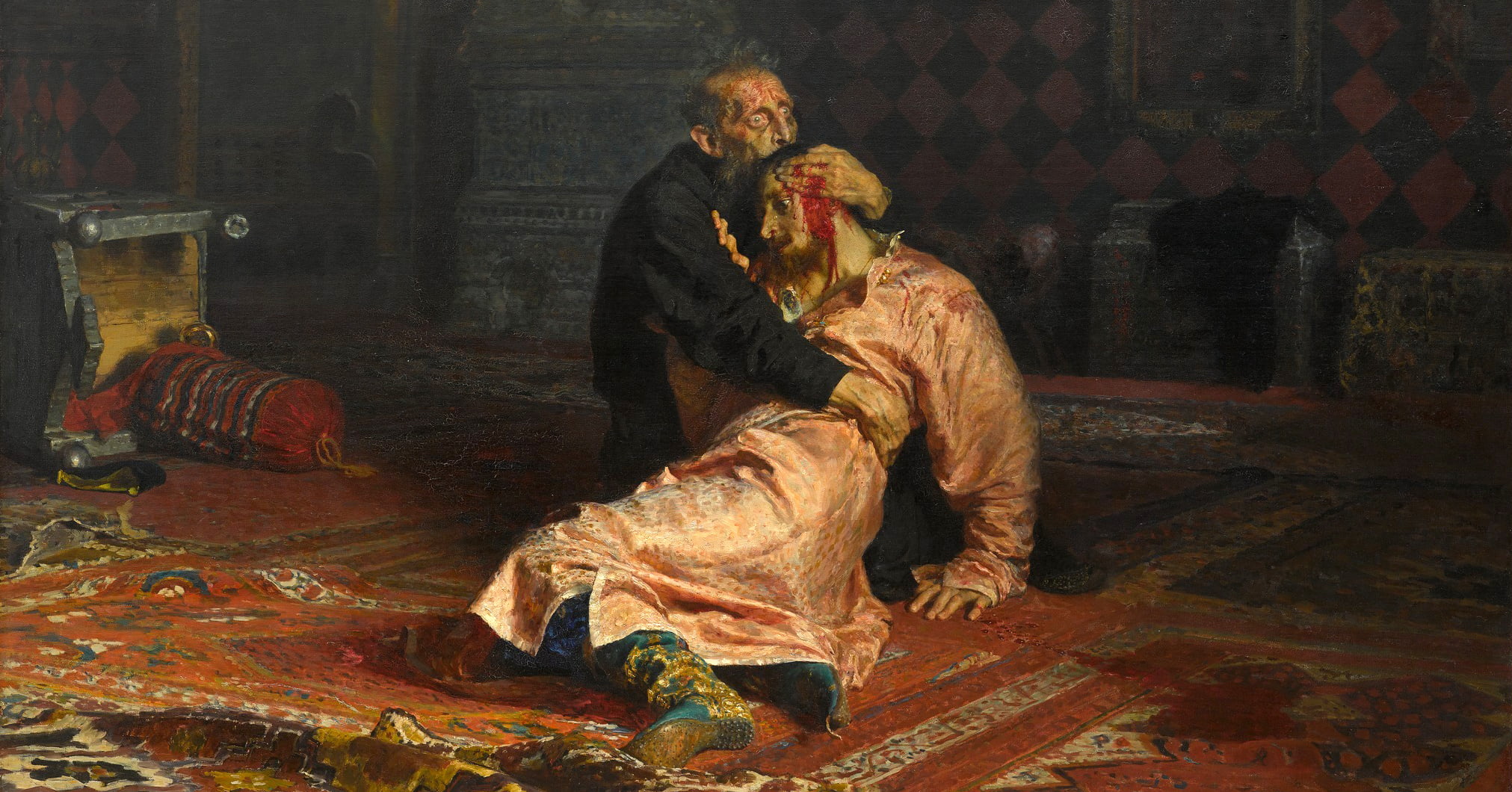It is widely believed that in a fit of anger, the king hit his heir with a staff - the resulting injury turned out to be fatal. We figured out what arguments there are in support of this version.
In many ways, the idea of Ivan the Terrible as the murderer of his own son exists thanks to the famous painting by Ilya Repin. Over the course of a century and a half, the canvas has not only been attracted attention of vandals and caused public discussions, but also so rooted in popular culture that it became a reason for memes and postmodern rethinking contemporary artists. The main Russian historians of the 19th century also reported on the murder of the prince: Nikolay Karamzin, Sergey Solovyov, Vasily Klyuchevsky and others.
Contemporaries described the circumstances of Tsarevich Ivan's death in different ways. Antonio Possevino, the first Jesuit to visit Moscow and leave records about Russia in the 16th century, reported directly on the murder. He tellsthat Ivan the Terrible beat his pregnant daughter-in-law with his staff, being dissatisfied with her appearance. The prince, who rushed to help his wife, also fell under the hot hand of his father and “was very seriously wounded in the head, almost in the temple, with the same staff.” “Having wounded his son, the father immediately indulged in deep grief and immediately called doctors and Andrei Shchelkalov and Nikita Romanovich from Moscow to have everything at hand. On the fifth day, the son died and was transferred to Moscow amid general grief,” concludes Possevino. Historian Vasily Klyuchevsky notesthat the Jesuit arrived in Moscow three months after the events he described, but nevertheless supports his version. True, in Klyuchevsky’s account, Ivan the Terrible “put his son to rest,” and in Possevino’s original version, the prince died a few days later.
Note that different sources of that time describe these events differently. Most surviving chronicles of the 16th century record only the fact of Ivan Ivanovich’s death, but say nothing about the blow with a staff. The version set out in the Pskov First Chronicle, impliesthat Ivan the Terrible did not hit, but “pricked” his son with an “ostium” because he proposed his own plan for waging war (the episode took place in 1580, a year before the death of the prince). When talking about the death of the heir, some contemporaries even talk about the murder as rumors. In "Vremennik" by clerk Ivan Timofeev approved: “Some say that his life was extinguished by the blow of his father’s hand because he wanted to keep his father from some unseemly act.”
The “scenario” of the alleged murder began to transform even more in the 19th century. For example, Karamzin in “The History of the Russian State” essentially combines two versions (a quarrel over a war without a fatal outcome and a sadly ended domestic conflict) into one. He reports: “During the negotiations for peace, suffering for Russia, reading the grief and on the faces of the boyars - hearing, perhaps, a general murmur - the prince was filled with noble jealousy, came to his father and demanded that he send him with an army to expel the enemy, liberate Pskov, and restore the honor of Russia. John, in a flurry of anger, shouted: “Rebel! You, together with the boyars, want to overthrow me from the throne!” and raised his hand. Boris Godunov wanted to keep her: the king gave him several wounds with his sharp staff and hit the prince hard in the head with it. This unfortunate man fell, bleeding profusely. Here John’s rage disappeared. Turning pale with horror, in awe, in a frenzy, he exclaimed: “I killed my son!” and rushed to hug and kiss him; held back the blood flowing from a deep ulcer; cried, sobbed, called doctors; I prayed to God for mercy, my son for forgiveness. But the heavenly judgment was completed!.. The Tsarevich, kissing his father’s hands, tenderly expressed love and compassion to him; urged him not to give in to despair; said that he was dying as a faithful son and subject... he lived for four days and died on November 19 in the terrible settlement of Aleksandrovskaya..."
Already at the beginning of the 20th century, the version of the murder of the prince ceased to be the only one. Historian Nikolai Likhachev after studying documents of the 16th century came to the conclusion that Ivan Ivanovich died not due to a blow with a staff, but due to an illness, the danger of which was initially underestimated. In particular, Likhachev draws attention to a letter from Ivan the Terrible, in which the Tsar reports about his son’s health problems.
A study of his remains could put an end to the debate about what caused the death of Ivan Ivanovich. In 1963, the tomb in the Archangel Cathedral of the Moscow Kremlin was opened. Specialists discovered in the preserved bones there is a significant excess of mercury content - this may indicate both not the most careful treatment (at that time they used mercury-containing preparations) and poisoning of the prince (possibly unintentional). What is much more important if we want to understand the story of the fatal blow with the staff is the skull of Ivan Jr. preserved so bad that it is not possible to detect the corresponding injuries (if any) on him.
Thus, the sources of the 16th century that have reached us give different descriptions of the death of Tsarevich Ivan, but even then some characterized the murder version as a rumor. In the 19th and early 20th centuries, domestic historians spoke about the fatal blow, thanks to whom, apparently, this episode became popular. However, there was no consensus among them not only regarding the circumstances of the murder, but also the “event of the crime” itself. The study of the remains of Ivan Ivanovich does not allow us to either confirm or refute these statements.
This is not accurate
- Arzamas. Fact check: 15 most popular legends about Ivan the Terrible
- Saving a masterpiece. Diary of the restoration of the painting “Ivan the Terrible and his son Ivan November 16, 1581” (1885)
If you find a spelling or grammatical error, please let us know by highlighting the error text and clicking Ctrl+Enter.







